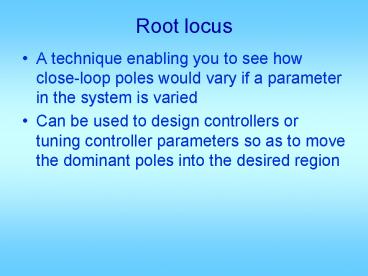Root locus - PowerPoint PPT Presentation
Title:
Root locus
Description:
A technique enabling you to see how close-loop poles would vary if a parameter in the system is varied Can be used to design controllers or tuning controller ... – PowerPoint PPT presentation
Number of Views:176
Avg rating:3.0/5.0
Title: Root locus
1
Root locus
- A technique enabling you to see how close-loop
poles would vary if a parameter in the system is
varied - Can be used to design controllers or tuning
controller parameters so as to move the dominant
poles into the desired region
2
- Recall step response specs are directly related
to pole locations - Let p-sjwd
- ts proportional to 1/s
- Mp determined by exp(-ps/wd)
- tr proportional to 1/p
- It would be really nice if we can
- Predict how the poles move when we tweak a system
parameter - Systematically drive the poles to the desired
region corresponding to desired step response
specs
3
Root Locus
k s(sa)
y
e
r
Example
-
Two parameters k and a. would like to know how
they affect poles
4
(No Transcript)
5
(No Transcript)
6
(No Transcript)
7
(No Transcript)
8
(No Transcript)
9
(No Transcript)
10
(No Transcript)
11
(No Transcript)
12
The root locus technique
- Obtain closed-loop TF and char eq d(s) 0
- Rearrange terms in d(s) by collecting those
proportional to parameter of interest, and those
not then divide eq by terms not proportional to
para. to get - this is called the root locus equation
- Roots of n1(s) are called open-loop zeros, mark
them with o in s-plane roots of d1(s) are
called open-loop poles, mark them with x in
s-plane
13
- The o and x marks falling on the real axis
divide the real axis into several segments. If a
segment has an odd total number of o and/or x
marks to its right, then n1(s)/d1(s) evaluated on
this segment will be negative real, and there is
possible k to make the root locus equation hold.
So this segment is part of the root locus. High
light it. If a segment has an even total number
of marks, then its not part of root locus. For
the high lighted segments, mark out going arrows
near a pole, and incoming arrow near a zero.
14
- Let npolesorder of system, mzeros. One root
locus branch comes out of each pole, so there are
a total of n branches. M branches goes to the m
finite zeros, leaving n-m branches going to
infinity along some asymptotes. The asymptotes
have angles (p 2lp)/(n-m). The asymptotes
intersect on the real axis at
15
- Imaginary axis crossing
- Go back to original char eq d(s)0
- Use Routh criteria special case 1
- Find k value to make a whole row 0
- The roots of the auxiliary equation are on jw
axis, give oscillation frequency, are the jw axis
crossing points of the root locus - When two branches meet and split, you have
breakaway points. They are double roots. d(s)0
and d(s) 0 also. Use this to solve for s and k. - Use matlab command to get additional details of
root locus - Let num n1(s)s coeff vector
- Let den d1(s)s coeef vector
- rlocus(num,den) draws locus for the root locus
equation - Should be able to do first 7 steps by hand.































